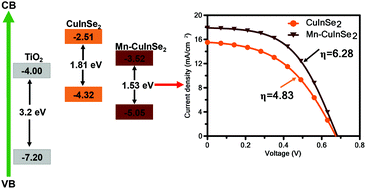Aqueous synthesis of Mn-doped CuInSe2 quantum dots to enhance the performance of quantum dot sensitized solar cells†
Abstract
Herein, we present the direct aqueous synthesis of manganese (Mn) doped CuInSe2 (Mn-CISe) quantum dots (QDs) under microwave irradiation to improve the photochemical properties of solar cells. As a result of Mn doping, the narrower bandgap energy of Mn-CISe leads to higher visible light absorption. The Mn-CISe QDs are therefore used as photosensitizers in quantum dot sensitized solar cells (QDSSCs), exhibiting enhanced performance which is dependent on Mn concentration. To the best of our knowledge, this is the first time to construct an Mn-CISe sensitized-TiO2 photoanode to boost the photovoltaic performance of QDSSCs. The incorporation of Mn into CISe increases short-circuit current, which is ascribed to the effective injection of the excited electrons from QDs into TiO2 and the consequent higher electron lifetime, likely through a newly formed Mn midgap in the CISe band structure. Compared to the undoped QDs, Mn-CISe QDSSCs show a shorter electron transport time (τt) and a longer electron recombination time (τr) which are studied by intensity-modulated photocurrent spectroscopy and intensity-modulated photovoltage spectroscopy, respectively. In fact, a combination of higher light-harvesting efficiency, slower charge recombination, and a longer electron lifetime gives rise to a maximum photovoltaic performance of 6.28%.



 Please wait while we load your content...
Please wait while we load your content...